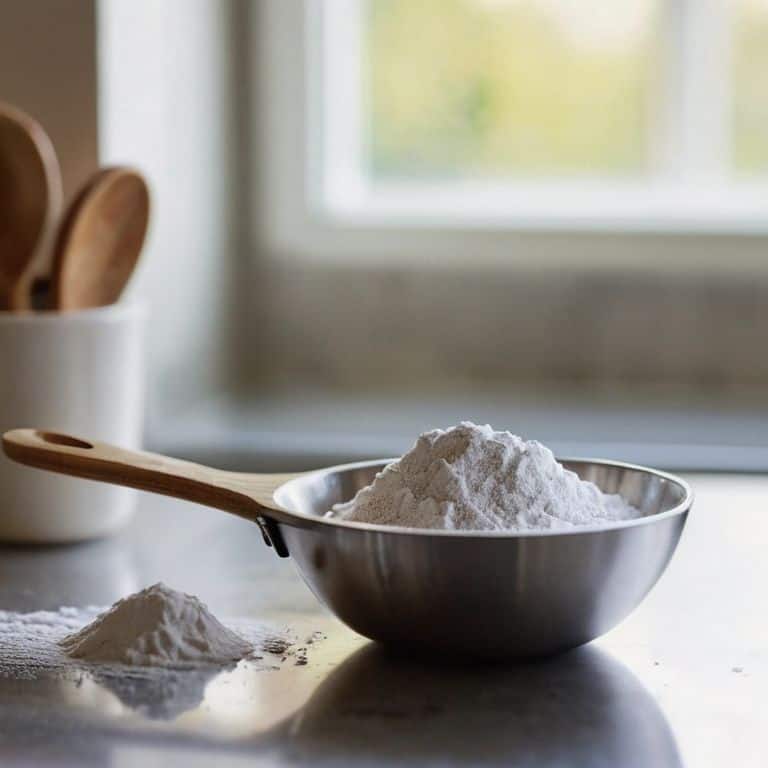As a flight instructor, I’ve seen my fair share of confusion – not just in the cockpit, but also in the kitchen. I’ve lost count of how many times my students have asked me about the difference between baking soda and baking powder while we’re taking a break from flight lessons. It’s amazing how two simple ingredients can cause so much uncertainty. I’ve found that the key to understanding their roles is to think of them like two different flight instruments: each has its own unique function, and using them correctly is crucial for a successful flight – or in this case, a successful recipe.
In this article, I promise to cut through the clutter and provide you with a clear, no-nonsense explanation of the difference between baking soda and baking powder. I’ll draw from my experience as a flight instructor to break down the complex into simple, easy-to-understand concepts. My goal is to empower you with the knowledge to make informed decisions in the kitchen, just as I do with my students in the cockpit. By the end of this article, you’ll be able to navigate the world of baking with confidence, knowing exactly when to use baking soda and when to use baking powder to make your recipes take off.
Table of Contents
- Navigating Baking Basics
- The Difference Between Baking Soda and Powder
- Flying High in the Kitchen: 5 Essential Tips for Mastering Baking Soda and Baking Powder
- Key Takeaways from the Flight Deck of Baking
- Understanding the Lift of Leavening Agents
- Landing Safely with Baking Essentials
- Frequently Asked Questions
Navigating Baking Basics

As we delve into the world of baking, it’s essential to understand the basics of leavening agents. Baking soda and baking powder are two commonly used ingredients that help our recipes take off, but they work in different ways. When I’m teaching my flight students about navigation, I always emphasize the importance of understanding the fundamentals. Similarly, in baking, grasping how these leavening agents function is crucial for achieving the desired outcome.
When it comes to substitutions in baking recipes, things can get a bit tricky. For instance, if you’re baking at high altitudes, you need to consider the effects of altitude on leavening. This is where understanding the role of acidity in baking soda reactions becomes vital. You see, baking soda needs an acidic component to activate its leavening properties, whereas baking powder already contains this acidic element. This distinction is crucial when deciding which ingredient to use in your recipe.
In my experience, double acting baking powder is a versatile ingredient that can be used in a variety of recipes. However, it’s essential to understand the difference between single acting vs double acting baking powder to ensure you’re using the right one for the job. By mastering these basics, you’ll be well on your way to becoming a skilled baker, capable of navigating even the most complex recipes with ease.
Effects of Altitude on Leavening
As we explore the world of baking, it’s essential to consider the effects of altitude on our recipes. Just like a pilot adjusts their flight plan according to weather conditions, bakers must adapt to their environment. At higher elevations, the air pressure is lower, which can impact the performance of leavening agents like baking soda and baking powder.
When baking at high altitudes, accurate measurements become even more crucial. The lower air pressure can cause baked goods to rise too quickly, leading to an uneven texture. By understanding how altitude affects leavening, bakers can make the necessary adjustments to achieve the perfect rise, just like a pilot navigates through turbulence to reach a smooth cruising altitude.
Substitutions in Baking Recipes
When it comes to substitutions in baking recipes, accuracy is crucial. You can’t just swap baking soda for baking powder or vice versa without considering the recipe’s chemical balance. I always tell my flight students that a good pre-flight checklist is essential, and the same applies to baking – double-checking your ingredients and their quantities is key to a successful outcome.
In certain situations, you can make educated substitutions, but this requires a deep understanding of how each ingredient functions within the recipe. As a flight instructor, I teach my students to think critically about the systems of an aircraft, and similarly, in baking, you need to consider how different ingredients interact to produce the desired result.
The Difference Between Baking Soda and Powder

When it comes to leavening agents, baking soda and baking powder are two essential components in many recipes. However, they serve distinct purposes and cannot be used interchangeably. Baking soda, also known as sodium bicarbonate, requires an acidic ingredient to activate its leavening properties, whereas baking powder already contains an acid and can be used on its own.
In certain situations, common baking powder substitutes can be used, but it’s crucial to understand the role of acidity in baking soda reactions. For example, when using baking soda, the presence of an acidic ingredient like buttermilk or yogurt helps to create a chemical reaction that releases carbon dioxide gas, causing the dough to rise. On the other hand, baking powder is often used in recipes that don’t contain acidic ingredients.
The type of baking powder used can also impact the final result. Double acting baking powder is a popular choice, as it releases gas twice during the baking process, providing a lighter and fluffier texture. In contrast, single acting vs double acting baking powder has distinct differences in terms of their reaction timing, which can affect the overall texture and consistency of the final product.
Role of Acidity in Baking Soda Reactions
When using baking soda in a recipe, it’s essential to understand the chemical reaction that occurs. Baking soda requires an acidic component to activate its leavening properties. This is where ingredients like buttermilk or yogurt come into play, as they provide the necessary acidity to trigger the reaction.
In the context of baking, balanced ingredients are crucial to ensuring that the baking soda reacts properly. If the acidity levels are off, the baking soda won’t be able to produce the desired leavening effect, resulting in a dense or flat final product.
Single vs Double Acting Baking Powder Uses
When it comes to baking powder, understanding the difference between single and double acting types is crucial. Single acting baking powder releases gas quickly, making it ideal for recipes where the batter is not going to sit for a long time. This type of baking powder is often used in recipes like cookies or pancakes, where the baking time is relatively short.
In contrast, double acting baking powder releases gas more slowly over time, making it perfect for recipes like cakes or breads that require a longer baking time. This allows for a more even rise and a lighter texture in the final product.
Flying High in the Kitchen: 5 Essential Tips for Mastering Baking Soda and Baking Powder
- Understand the role of acidity: Just like how a pilot needs to understand wind direction, you need to know how acidity affects baking soda reactions to get the best results
- Choose the right powder: Single or double acting, baking powder is like selecting the right fuel for your flight – it depends on your mission, or in this case, your recipe
- Respect the ratio: Too much baking soda or powder can be like overloading your aircraft – it’s all about balance, so follow the recipe and don’t overdo it
- Consider your altitude: Baking at high altitudes requires adjustments, just like flying in different air pressures – know your environment to ensure your baked goods soar
- Keep them fresh: Store baking soda and baking powder properly to maintain their potency, just as you would keep your aircraft in top condition – a well-maintained kitchen is a happy kitchen
Key Takeaways from the Flight Deck of Baking
Understanding the difference between baking soda and baking powder is crucial for successful baking, just like knowing your aircraft’s instruments is key to safe flying
Substitutions in recipes can be made with caution, considering factors like altitude and acidity, much like how pilots adjust their flight plans according to weather conditions
Mastering the roles of baking soda and powder, including their reactions and uses, can elevate your baking skills, similar to how a solid grasp of aerodynamics improves your flying abilities
Understanding the Lift of Leavening Agents
Just as a pilot must understand the nuances of lift and drag to navigate the skies, a baker must grasp the difference between baking soda and baking powder to make their recipes soar – it’s all about balance and timing.
Daniel Sato
Landing Safely with Baking Essentials

As we touch down on our discussion about the difference between baking soda and baking powder, it’s essential to remember the basics. We’ve navigated through the world of baking, understanding how substitutions in recipes, effects of altitude, and the roles of acidity and single vs double acting powders play crucial parts. By grasping these concepts, you’re not just a better baker, but you’re also applying principles similar to those used in flight planning, where every detail matters for a successful journey. This analogy isn’t far-fetched; just as a pilot must understand the weather and their aircraft, a baker must understand their ingredients and environment.
In conclusion, the art of baking, much like the art of flying, is about precision and patience. As you continue on your baking journey, keep in mind that practice makes perfect, and don’t be afraid to experiment and learn from your mistakes. Whether you’re soaring through the skies or rising to the occasion with a perfectly baked loaf, the sense of accomplishment is unparalleled. So, go ahead, take to the skies or the kitchen, and remember, every great flight or bake starts with a solid understanding of the fundamentals.
Frequently Asked Questions
Can I substitute baking soda for baking powder in a recipe without affecting the final product?
Not exactly, substituting baking soda for baking powder can be tricky. As your ‘ground school’ instructor, I’d say think of it like switching aircraft – you need to consider the mission, or in this case, the recipe’s acidity level and leavening needs. Baking soda requires an acidic component to activate, whereas baking powder is self-contained.
How does the acidity level in a recipe impact the choice between baking soda and baking powder?
Acidity levels are key when choosing between baking soda and powder. Think of it like navigating through turbulence – you need the right conditions to stay on course. Baking soda requires an acidic environment to activate, whereas baking powder has its own built-in acid. So, if your recipe has a natural acidity, like buttermilk or yogurt, baking soda is a better choice.
What are the consequences of using single-acting versus double-acting baking powder in terms of leavening and texture?
Think of it like adjusting your aircraft’s throttle – single-acting baking powder provides a quick burst of leavening, while double-acting releases gas more slowly, affecting texture and rise. Using the wrong type can be like flying with incorrect altitude settings, leading to uneven results or even recipe failure.
